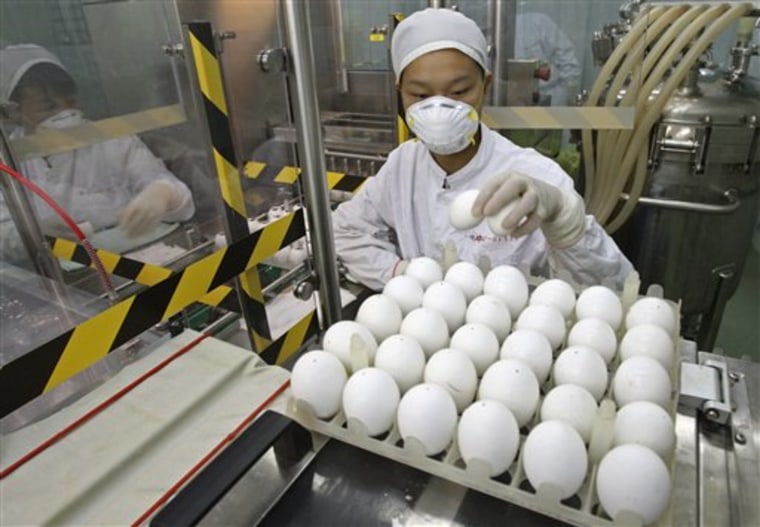The answer may be near to a crucial question about vaccine for the advancing swine flu — one shot or two?
Chinese officials say they are about to approve vaccines that prevent the new flu in a single dose.
If they’re right, it would be good news. Many health researchers fear it will take two shots to protect people, vastly complicating efforts to stem the spread of the illness.
The World Health Organization says it is encouraged after reviewing the test details from one of the two Chinese vaccines. However, experts said more results are needed from other vaccine makers to determine if one dose would be potent enough.
Australia-based CSL should know within days whether one dose of its vaccine, administered to volunteers in that country in late July, was enough. CSL to date has been mum.
In about two weeks, the U.S. expects to announce initial test results from its vaccine, which is the same type as one of the Chinese versions, said Dr. Anthony Fauci of the U.S. National Institutes of Health.
“From what I’ve seen and heard of the data, it looks encouraging,” Fauci said of the clinical trials of the Chinese vaccine from Sinovac Biotech Ltd. “This is very good news. Let’s hope the material that we’re using has similar results.”
Dr. Tom Frieden, director of the federal Centers for Disease Control and Prevention, said his agency would need to review data suggesting that one dose of H1N1 vaccine will be enough and suggested that it might vary by population.
"It's very likely that at least for kids, two doses are going to be required," Frieden said.
Most experts, however, are optimistic at the prospect of a success of a single shot.
“Everybody is desperately hoping that one (shot) will do because then that’s much easier to administer,” said Jodie McVernon, a vaccine expert at the University of Melbourne who is involved in Australian trials of swine flu vaccines for young children. She had not seen the Chinese trial results.
However, James McGlothlin, a member of Purdue University’s pandemic planning committee, was cautious about the Chinese report.
“They’ve got some very good scientists over there, but anything that sounds too good to be true ought to be scrutinized,” he said in a telephone interview.
“I’d like to look at some of the clinical trials,” that led to the one-dose conclusion, he said. “In China, the rules are a little bit different in terms of human subjects,” and it’s not clear what safety factors were in place, he said.
China’s State Food and Drug Administration said on its Web site it will make a decision this week on approving the two vaccines, which completed testing last month and passed reviews by panels of about 40 experts. Four other vaccines are being reviewed, it said.
Government-backed vaccine makers Sinovac and Hualan Biological Engineering Inc. said their studies show one shot of vaccine is effective on people ages 3 to 60. More than 3,000 people participated in the trials.
Sinovac says it has the capacity to produce up to 30 million doses of swine flu vaccine in a year, while Hualan said it can make 160 million doses.
Stockpiling vaccines is China’s latest move in its aggressive approach to contain the spread of swine flu in the country of 1.3 billion people and relatively limited medical resources. It has quarantined travelers on suspicion of contact with infected people and ordered schools to test students’ temperatures.
The Health Ministry says around 3,700 cases of swine flu have been confirmed on the mainland — none fatal.
China aims to have enough swine flu vaccine for 5 percent of the public by the end of the year, and although health officials have not released detailed vaccination plans, they have said health workers, public service workers and students are priority groups.
Should China export vaccines, however, quality concerns could arise.
Though China is a worldwide manufacturing center for pharmaceuticals, suppliers have been known to substitute cheaper and sometimes lethal ingredients. Tainted cough syrup was linked to several deaths in Central America and blood thinners made with contaminated products are suspected in dozens of deaths in the U.S. in recent years.
Last week, Mexico’s health secretary, Jose Angel Cordova, said Mexico is considering buying vaccines from China, which would be more than 40 percent cheaper than other vaccines being offered to the government. But Mexico would want a guarantee that China’s vaccine is safe and effective, he said.
The World Health Organization said information provided by Sinovac showed that in studies, the vaccines were tested in three formulations of 15 micrograms per dose, and all gave antibody responses that satisfied regulatory criteria. That vaccine dose is the same amount the U.S. government is testing.
“We have no reason to doubt what Sinovac is reporting,” said Melinda Henry, a WHO spokeswoman in Geneva. “Certainly if one dose proves sufficient to produce the desired immune response, this would be very encouraging in terms of augmenting the global supply of vaccine in the near future.”
International health experts say swine flu has not been as severe as initially feared. At least 2,185 people have died, but most cases are mild and require no treatment. Worries remain that a rash of new infections could overwhelm hospitals and health authorities, particularly in poorer countries.
White House advisers have estimated that in a worst case scenario, half the U.S. population could become infected and the World Health Organization predicts that within two years nearly one-third of the world’s population will have caught it.
